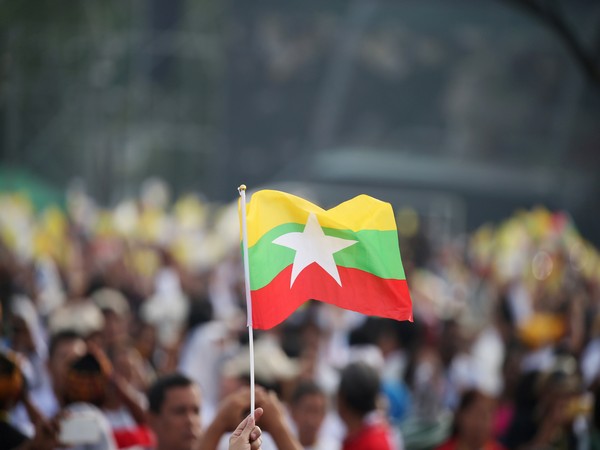
Behind the 'revolution' led by Myanmar's ethnic minority fighters
Dec 21, 2023
Namhsan [Myanmar], December 21: Pickup trucks carrying ethnic minority fighters rolled into a town in Myanmar's northeastern Shan state recently cleared of junta troops - another victory redrawing the frontlines of the country's civil war. The convoy passed the golden spire of a Buddhist pagoda in Namhsan but most eyes were scanning the skies for the attack jets the junta is using to support its embattled ground troops.
The men jumped down from the vehicles and fanned out on foot past locked wooden houses and down deserted streets silenced by days of fighting. A burst of gunfire revealed a pocket of junta troops on the edge of the town and sent the fighters scuttling for cover behind walls.
Nestled in the hills of northern Shan state, Namhsan is the latest town to fall to Ta'ang National Liberation Army (TNLA) fighters since they launched a surprise offensive against Myanmar's junta in October. The TNLA announced it had captured Namhsan on Saturday. Footage obtained by AFP shows the fighters in the last stages of their operation to secure the town last week.
On the road to Namhsan hours before the TNLA moved in, its spokesman Tar Aik Kyaw said his fighters were "walking the revolutionary path." "The main objective is to take down the military dictatorship, which is what Myanmar people always want." Nearby, a squad of fighters in camouflage fatigues and peaked caps with badges showing the TNLA emblem set against a blue sky, unloaded crates of mortars for a final check before heading into battle.
Desperate civilians
For almost three years, civilian "People's Defense Forces" have been battling around the country to oust the junta which seized power in a 2021 coup. But the offensive launched by the TNLA and its allies - the Arakan Army (AA) and Myanmar National Democratic Alliance Army (MNDAA) - in October has galvanized the anti-junta movement and presented the generals with their stiffest military challenge in decades, with groups attacking on multiple fronts.
Evidence of fierce fighting was everywhere in Namhsan. One of the pagoda's spires had been knocked down, an unexploded rocket lay on the ground and a building was riddled with bullet holes. Inside, a dark pool of blood stained the floor next to blankets and food wrappers, while in the next room more blood was smeared on the walls. Residents who have not already fled live in fear.
"We don't have anywhere to go. There are caves to hide in but they are a long way from our house," said Ohmar, 50, who asked to use a pseudonym for security reasons. "My neighbors left this morning to hide in the caves but on the way artillery shells started landing all around them and so they came back here," she said.
One man dug a hole into the side of a hill to make a rudimentary shelter - an action familiar to many across Myanmar after three years of conflict. "I already sent my family members to other places," resident Zaw Oo said.
Ohmar, whose house walls were perforated by bullet holes, has also dug a rough shelter that she said could hold up to 20 people. "But it's very tight and hot inside. If we don't cover the whole entrance with sandbags, we are also afraid of artillery shells," she said. "I'm so worried for my family."
Drones
Later, under cover of darkness, a TNLA commander whispered urgent orders into a walkie-talkie, calling in a new tactic that has put the Myanmar military on the back foot - a drone strike. Within minutes a drone was primed with a bomb and buzzed up into the night air to target a tea factory outside Namhsan where junta troops were holding out.
Soon a flash lit up the night sky and an explosion rumbled across the hills, prompting muffled cheers from TNLA fighters. The drones used by the ethnic minority groups are civilian models modified to carry "drop bombs" that are released over the target. The tactic may be simple but it has caused the junta enough problems for it to put out a statement condemning the TNLA, MNDAA and AA for using "thousands" of drop bombs and accusing the groups of receiving "foreign" help.
Tar Aik Kyaw said the TNLA was "not under the control" of any group or country. "We have launched attacks against the military to protect the lives of civilians, to prevent the military's air strikes and attacks on the TNLA," he said. "Our areas are near China's border region and we have some discussions [with them]. But we don't discuss military issues, we have discussed stabilization of the border and participation in suppressing online scams."
Beijing has been angered by a mushrooming of online scam operations in Myanmar's lawless borderlands staffed by Chinese citizens forced to work swindling their compatriots. The alliance says one of the goals of its offensive is to eradicate the scam operations - in what analysts say is likely a nod to a powerful neighbor which maintains ties with some of Myanmar's myriad ethnic minority armed groups.
Ceasefire hopes
More than 600,000 people are estimated to have been displaced and 378 civilians killed since the alliance launched its offensive on October 27, according to the United Nations. On Thursday, Beijing announced it had mediated a temporary ceasefire between the junta and the ethnic minority armed groups, but it is not clear how far this is holding on the ground.
And while the alliance offensive has captured some towns, TNLA spokesman Tar Aik Kyaw urged caution. "A thirsty person is happy when he sees water," he said. "We have noticed how Myanmar people are happy and hopeful for the win over military. But we can't depend on one organization to defeat the military. "All the people have the responsibility to participate." - AFP
Source: Kuwait Times






